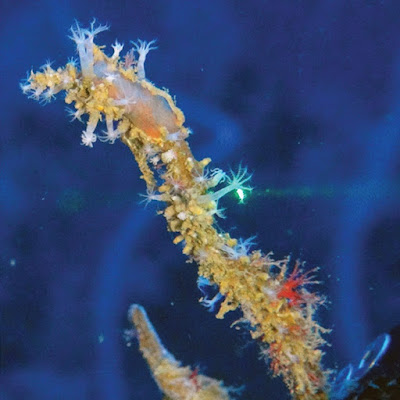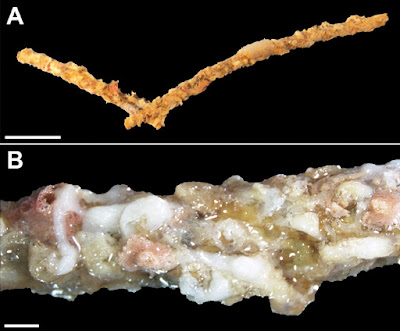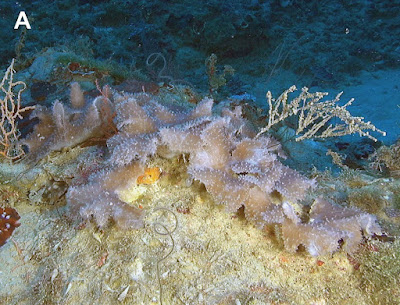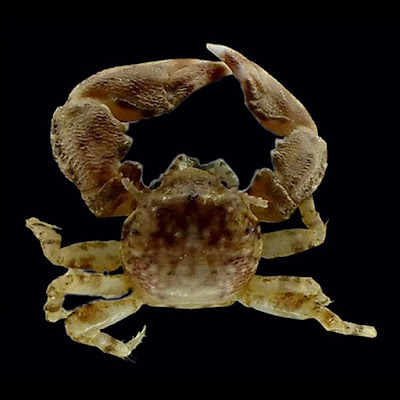 |
| Figure 1: In situ photographs of Cyphoma species. Cyphoma species showing different mantle patterns and colouration. (A) Cyphoma gibbosum on Pseudoplexaura sp. (B) C. gibbosum on Pseudoplexaura sp. (E) C. signatum on Plexaurella dichotoma (see Reijnen, Hoeksema & Gittenberger, 2010: Fig. 1B) (F) Juvenile C. signatum on Gorgonia ventalina (G) Cyphoma “black morph” on Eunicea tourneforti (H) C. mcgintyi from Florida, USA. Photos: (A–G) B.T. Reijnen, all from Curaçao; (H) Florida Museum of Natural History. DOI: 10.7717/peerj.3018 |
Abstract
The iconic gastropod genus Cyphoma is commonly observed in the Caribbean, where it lives in association with various octocorallian hosts. Each species in the genus Cyphoma has a unique, characteristic mantle pattern and colouration, which separates the valid taxa. Because of its abundance and recognisability Cyphoma gibbosum has been used as a model organism in several studies concerning allelochemicals, reef degradation, and physical defence mechanisms. Molecular analyses based on four molecular markers (COI, 16S, H3 and 28S) for three Cyphoma species (C. gibbosum, C. mcgintyi, C. signatum) and an unidentified black morph, collected from three localities in the Caribbean, show that they represent morphological varieties of a single, genetically homogeneous species. This outcome is in agreement with previous anatomical studies. As a result C. mcgintyi and C. signatum are synonymised with C. gibbosum, which is a key result for future work using C. gibbosum as a model organism. The striking morphological differences in mantle pattern and colouration are hypothesised to be the result of one of three possible scenarios: rapid divergence, supergenes (including balanced polymorphism), or incipient speciation.
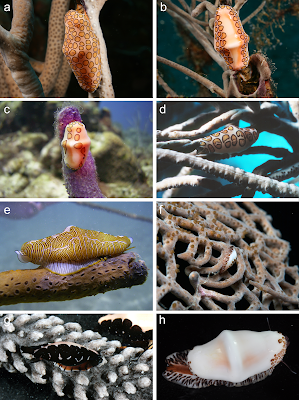 |
Figure 1: In situ photographs of Cyphoma species. Cyphoma species showing different mantle patterns and colouration (A) Cyphoma gibbosum on Pseudoplexaura sp. (B) C. gibbosum on Pseudoplexaura sp. (C) C. gibbosum with atypical mantle pattern (only dots around mantle edges) on Briareum asbestinum (D) C. cf. allenae on Antillogorgia americana (E) C. signatum on Plexaurella dichotoma (see Reijnen, Hoeksema & Gittenberger, 2010: Fig. 1B) (F) Juvenile C. signatum on Gorgonia ventalina (G) Cyphoma “black morph” on Eunicea tourneforti (H) C. mcgintyi from Florida, USA. Photos: (A–G) B.T. Reijnen, all from Curaçao; (H) Florida Museum of Natural History. DOI: 10.7717/peerj.3018 |
 |
| Figure 1: In situ photographs of Cyphoma species. Cyphoma species showing different mantle patterns and colouration (A) Cyphoma gibbosum on Pseudoplexaura sp. (B) C. gibbosum on Pseudoplexaura sp. (C) C. gibbosum with atypical mantle pattern (only dots around mantle edges) on Briareum asbestinum (D) C. cf. allenae on Antillogorgia americana Photos: (A–D) B.T. Reijnen, all from Curaçao. DOI: 10.7717/peerj.3018 |
 |
| Figure 1: In situ photographs of Cyphoma species. Cyphoma species showing different mantle patterns and colouration. (E) C. signatum on Plexaurella dichotoma (see Reijnen, Hoeksema & Gittenberger, 2010: Fig. 1B) (F) Juvenile C. signatum on Gorgonia ventalina (G) Cyphoma “black morph” on Eunicea tourneforti (H) C. mcgintyi from Florida, USA. Photos: (E–G) B.T. Reijnen, all from Curaçao; (H) Florida Museum of Natural History. DOI: 10.7717/peerj.3018 |
Bastian T. Reijnen and Sancia E.T. van der Meij. 2017. Coat of Many Colours — DNA Reveals Polymorphism of Mantle Patterns and Colouration in Caribbean Cyphoma Röding, 1798 (Gastropoda, Ovulidae).
PeerJ. 5:e3018. DOI: 10.7717/peerj.3018
PeerJ. 5:e3018. DOI: 10.7717/peerj.3018
---------------------------------------------------------------
روابط التحميل والمشاهدة، الروابط المباشرة للتحميل
او
شاهد هذا الفيديو القصير لطريقة التحميل البسيطة
كيف تحصل على مدونة جاهزة بآلاف المواضيع والمشاركات من هنا
شاهد قناة منتدى مدونات بلوجر جاهزة بألاف المواضيع والمشاركات على اليوتيوب لمزيد من الشرح من هنا
رابط مدونة منتدى مدونات بلوجر جاهزة بآلاف المواضيع والمشاركات في أي وقت حــــتى لو تم حذفها من هنا
شاهد صفحة منتدى مدونات بلوجر جاهزة بألاف المواضيع والمشاركات على الفيس بوك لمزيد من الشرح من هنا
شاهد صفحة منتدى مدونات بلوجر جاهزة بألاف المواضيع والمشاركات على الفيس بوك لمزيد من الشرح من هنا
تعرف على ترتيب مواضيع منتدى مدونات بلوجر جاهزة بآلاف المواضيع والمشاركات (حتى لا تختلط عليك الامور) من هنا
ملاحظة هامة: كل عمليات تنزيل، رفع، وتعديل المواضيع الجاهزة تتم بطريقة آلية، ونعتذر عن اي موضوع مخالف او مخل بالحياء مرفوع بالمدونات الجاهزة بآلاف المواضيع والمشاركات، ولكم ان تقوموا بحذف هذه المواضيع والمشاركات والطريقة بسيطة وسهلة. ــــــــــــــــــــــــــــــــــــــــــــــــــــــــــــــــــــــــــــــسلامـ.







